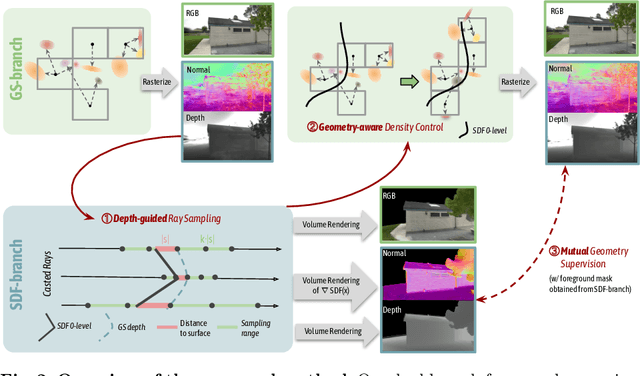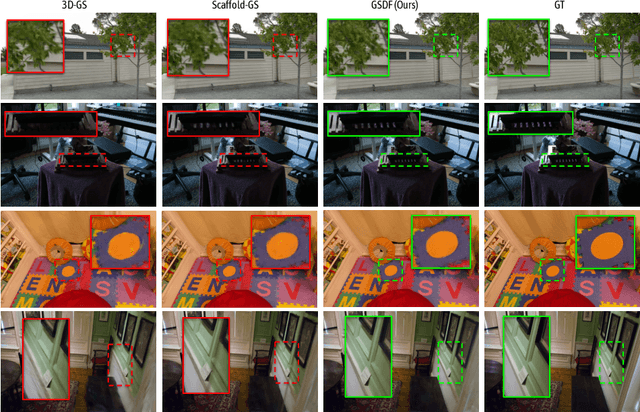Lihan Jiang
AnySplat: Feed-forward 3D Gaussian Splatting from Unconstrained Views
May 29, 2025Abstract:We introduce AnySplat, a feed forward network for novel view synthesis from uncalibrated image collections. In contrast to traditional neural rendering pipelines that demand known camera poses and per scene optimization, or recent feed forward methods that buckle under the computational weight of dense views, our model predicts everything in one shot. A single forward pass yields a set of 3D Gaussian primitives encoding both scene geometry and appearance, and the corresponding camera intrinsics and extrinsics for each input image. This unified design scales effortlessly to casually captured, multi view datasets without any pose annotations. In extensive zero shot evaluations, AnySplat matches the quality of pose aware baselines in both sparse and dense view scenarios while surpassing existing pose free approaches. Moreover, it greatly reduce rendering latency compared to optimization based neural fields, bringing real time novel view synthesis within reach for unconstrained capture settings.Project page: https://city-super.github.io/anysplat/
MV-CoLight: Efficient Object Compositing with Consistent Lighting and Shadow Generation
May 27, 2025Abstract:Object compositing offers significant promise for augmented reality (AR) and embodied intelligence applications. Existing approaches predominantly focus on single-image scenarios or intrinsic decomposition techniques, facing challenges with multi-view consistency, complex scenes, and diverse lighting conditions. Recent inverse rendering advancements, such as 3D Gaussian and diffusion-based methods, have enhanced consistency but are limited by scalability, heavy data requirements, or prolonged reconstruction time per scene. To broaden its applicability, we introduce MV-CoLight, a two-stage framework for illumination-consistent object compositing in both 2D images and 3D scenes. Our novel feed-forward architecture models lighting and shadows directly, avoiding the iterative biases of diffusion-based methods. We employ a Hilbert curve-based mapping to align 2D image inputs with 3D Gaussian scene representations seamlessly. To facilitate training and evaluation, we further introduce a large-scale 3D compositing dataset. Experiments demonstrate state-of-the-art harmonized results across standard benchmarks and our dataset, as well as casually captured real-world scenes demonstrate the framework's robustness and wide generalization.
Scene4U: Hierarchical Layered 3D Scene Reconstruction from Single Panoramic Image for Your Immerse Exploration
Apr 01, 2025Abstract:The reconstruction of immersive and realistic 3D scenes holds significant practical importance in various fields of computer vision and computer graphics. Typically, immersive and realistic scenes should be free from obstructions by dynamic objects, maintain global texture consistency, and allow for unrestricted exploration. The current mainstream methods for image-driven scene construction involves iteratively refining the initial image using a moving virtual camera to generate the scene. However, previous methods struggle with visual discontinuities due to global texture inconsistencies under varying camera poses, and they frequently exhibit scene voids caused by foreground-background occlusions. To this end, we propose a novel layered 3D scene reconstruction framework from panoramic image, named Scene4U. Specifically, Scene4U integrates an open-vocabulary segmentation model with a large language model to decompose a real panorama into multiple layers. Then, we employs a layered repair module based on diffusion model to restore occluded regions using visual cues and depth information, generating a hierarchical representation of the scene. The multi-layer panorama is then initialized as a 3D Gaussian Splatting representation, followed by layered optimization, which ultimately produces an immersive 3D scene with semantic and structural consistency that supports free exploration. Scene4U outperforms state-of-the-art method, improving by 24.24% in LPIPS and 24.40% in BRISQUE, while also achieving the fastest training speed. Additionally, to demonstrate the robustness of Scene4U and allow users to experience immersive scenes from various landmarks, we build WorldVista3D dataset for 3D scene reconstruction, which contains panoramic images of globally renowned sites. The implementation code and dataset will be released at https://github.com/LongHZ140516/Scene4U .
Horizon-GS: Unified 3D Gaussian Splatting for Large-Scale Aerial-to-Ground Scenes
Dec 02, 2024



Abstract:Seamless integration of both aerial and street view images remains a significant challenge in neural scene reconstruction and rendering. Existing methods predominantly focus on single domain, limiting their applications in immersive environments, which demand extensive free view exploration with large view changes both horizontally and vertically. We introduce Horizon-GS, a novel approach built upon Gaussian Splatting techniques, tackles the unified reconstruction and rendering for aerial and street views. Our method addresses the key challenges of combining these perspectives with a new training strategy, overcoming viewpoint discrepancies to generate high-fidelity scenes. We also curate a high-quality aerial-to-ground views dataset encompassing both synthetic and real-world scene to advance further research. Experiments across diverse urban scene datasets confirm the effectiveness of our method.
Octree-GS: Towards Consistent Real-time Rendering with LOD-Structured 3D Gaussians
Mar 26, 2024Abstract:The recent 3D Gaussian splatting (3D-GS) has shown remarkable rendering fidelity and efficiency compared to NeRF-based neural scene representations. While demonstrating the potential for real-time rendering, 3D-GS encounters rendering bottlenecks in large scenes with complex details due to an excessive number of Gaussian primitives located within the viewing frustum. This limitation is particularly noticeable in zoom-out views and can lead to inconsistent rendering speeds in scenes with varying details. Moreover, it often struggles to capture the corresponding level of details at different scales with its heuristic density control operation. Inspired by the Level-of-Detail (LOD) techniques, we introduce Octree-GS, featuring an LOD-structured 3D Gaussian approach supporting level-of-detail decomposition for scene representation that contributes to the final rendering results. Our model dynamically selects the appropriate level from the set of multi-resolution anchor points, ensuring consistent rendering performance with adaptive LOD adjustments while maintaining high-fidelity rendering results.
GSDF: 3DGS Meets SDF for Improved Rendering and Reconstruction
Mar 25, 2024



Abstract:Presenting a 3D scene from multiview images remains a core and long-standing challenge in computer vision and computer graphics. Two main requirements lie in rendering and reconstruction. Notably, SOTA rendering quality is usually achieved with neural volumetric rendering techniques, which rely on aggregated point/primitive-wise color and neglect the underlying scene geometry. Learning of neural implicit surfaces is sparked from the success of neural rendering. Current works either constrain the distribution of density fields or the shape of primitives, resulting in degraded rendering quality and flaws on the learned scene surfaces. The efficacy of such methods is limited by the inherent constraints of the chosen neural representation, which struggles to capture fine surface details, especially for larger, more intricate scenes. To address these issues, we introduce GSDF, a novel dual-branch architecture that combines the benefits of a flexible and efficient 3D Gaussian Splatting (3DGS) representation with neural Signed Distance Fields (SDF). The core idea is to leverage and enhance the strengths of each branch while alleviating their limitation through mutual guidance and joint supervision. We show on diverse scenes that our design unlocks the potential for more accurate and detailed surface reconstructions, and at the meantime benefits 3DGS rendering with structures that are more aligned with the underlying geometry.
PAD: A Dataset and Benchmark for Pose-agnostic Anomaly Detection
Oct 11, 2023



Abstract:Object anomaly detection is an important problem in the field of machine vision and has seen remarkable progress recently. However, two significant challenges hinder its research and application. First, existing datasets lack comprehensive visual information from various pose angles. They usually have an unrealistic assumption that the anomaly-free training dataset is pose-aligned, and the testing samples have the same pose as the training data. However, in practice, anomaly may exist in any regions on a object, the training and query samples may have different poses, calling for the study on pose-agnostic anomaly detection. Second, the absence of a consensus on experimental protocols for pose-agnostic anomaly detection leads to unfair comparisons of different methods, hindering the research on pose-agnostic anomaly detection. To address these issues, we develop Multi-pose Anomaly Detection (MAD) dataset and Pose-agnostic Anomaly Detection (PAD) benchmark, which takes the first step to address the pose-agnostic anomaly detection problem. Specifically, we build MAD using 20 complex-shaped LEGO toys including 4K views with various poses, and high-quality and diverse 3D anomalies in both simulated and real environments. Additionally, we propose a novel method OmniposeAD, trained using MAD, specifically designed for pose-agnostic anomaly detection. Through comprehensive evaluations, we demonstrate the relevance of our dataset and method. Furthermore, we provide an open-source benchmark library, including dataset and baseline methods that cover 8 anomaly detection paradigms, to facilitate future research and application in this domain. Code, data, and models are publicly available at https://github.com/EricLee0224/PAD.
MatrixCity: A Large-scale City Dataset for City-scale Neural Rendering and Beyond
Sep 28, 2023



Abstract:Neural radiance fields (NeRF) and its subsequent variants have led to remarkable progress in neural rendering. While most of recent neural rendering works focus on objects and small-scale scenes, developing neural rendering methods for city-scale scenes is of great potential in many real-world applications. However, this line of research is impeded by the absence of a comprehensive and high-quality dataset, yet collecting such a dataset over real city-scale scenes is costly, sensitive, and technically difficult. To this end, we build a large-scale, comprehensive, and high-quality synthetic dataset for city-scale neural rendering researches. Leveraging the Unreal Engine 5 City Sample project, we develop a pipeline to easily collect aerial and street city views, accompanied by ground-truth camera poses and a range of additional data modalities. Flexible controls over environmental factors like light, weather, human and car crowd are also available in our pipeline, supporting the need of various tasks covering city-scale neural rendering and beyond. The resulting pilot dataset, MatrixCity, contains 67k aerial images and 452k street images from two city maps of total size $28km^2$. On top of MatrixCity, a thorough benchmark is also conducted, which not only reveals unique challenges of the task of city-scale neural rendering, but also highlights potential improvements for future works. The dataset and code will be publicly available at our project page: https://city-super.github.io/matrixcity/.
 Add to Chrome
Add to Chrome Add to Firefox
Add to Firefox Add to Edge
Add to Edge